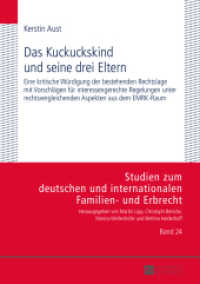Full Description
The Routledge Handbook of the Translation Industry provides an accessible and comprehensive overview of current and emerging practices, workflows, and processes in the translation industry, the professional and socio-economic contexts in which industry actors operate, and best practices in translation industry teaching and research in this rapidly developing field.
Comprising 33 chapters from scholarly and industry voices, this handbook addresses the many issues arising from growing technologisation, new trends in translation procurement and production, and increasing pressures on the range of actors in the translation industry. The content spans both bottom-up and top-down perspectives, using a variety of theoretical, praxiological, and data-driven approaches.
In addition to providing coverage of a range of well-established professional profiles, workflows, and resources, this handbook adopts a novel approach in addressing emerging topics such as global sustainable development and wellbeing, economics, the platform economy, and social media and the influencer economy. The opening mapping chapter and final roundtable chapter provide fitting conceptual and forward-looking bookends for the content.
This handbook offers a topical and much-needed forum to engage with the challenges and opportunities facing the translation industry and constitutes an essential point of reference for students and researchers of translation as well as industry practitioners and professionals.
Chapter 4 of this book is freely available as a downloadable Open Access PDF at http://www.taylorfrancis.com under a Creative Commons [Attribution-Non Commercial-No Derivatives (CC BY-NC-ND)] 4.0 license.
Contents
List of Figures
Advisory Board
Notes on Contributors
Acknowledgements
PART I
Concepts and Context
1 What's in a Name? Mapping the Translation Industry
Callum Walker and Joseph Lambert
2 Changing Practices in the Translation Industry
Akiko Sakamoto
PART II
Processes and Practices
3 Freelance Translation
JC Penet
4 Institutional and In‑House Translation
Fernando Prieto Ramos and Ingemar Strandvik
5 Translation Quality
Tomáš Svoboda
6 Subtitling for Translation and Accessibility
Stavroula Sokoli and Paweł Aleksandrowicz
7 Dubbing and Voiceover
Rocío Baños
8 Software Application Localisation
Bert Esselink
9 Game Localisation
Xiaochun Zhang
PART III
Resources and Management
10 Perspectives on Computer‑Assisted Translation Software
Dragoș Ciobanu
11 Perspectives on Machine Translation, Post‑Editing, and Automation
Ana Guerberof‑Arenas
12 Ergonomics in Translation Work
Maureen Ehrensberger‑Dow and Andrea Hunziker Heeb
13 Translation Project Management
Raisa McNab
14 Human Resource Management
Angie Tapia
15 Translation Management Systems
Ramunė Kasperė
PART IV
Economics and Markets
16 Economic Perspectives on the Translation Industry
Thomas A. Hanson, Christopher D. Mellinger and Callum Walker
17 Platform Economy Models in the Translation Industry
Gökhan Fırat and Mehmet Şahin
18 Diversification and Portfolio Careers
Erik Angelone
19 Status, Professionalism, and Professionalisation
Christy Fung‑ming Liu
20 Non‑Professional Translation and Crowdsourcing
Miguel A. Jiménez‑Crespo
21 Media Accessibility
Anna Jankowska and Gert Vercauteren
22 The Literary Translation Industry
Susan Pickford
PART V
Communities and Society
23 Professional Translator Associations
Eleanor Cornelius
24 Risk and Trust in the Translation Industry
Carmen Canfora
25 Translator Ethics
Phillippa May Bennett
26 Translation Industry Ethics
Joss Moorkens
27 Global Sustainable Development and Wellbeing
Séverine Hubscher‑Davidson and Stéphanie Panichelli‑Batalla
28 Social Media, the Translation Industry, and the Influencer Economy
Renée Desjardins
PART VI
Pedagogy and Research
29 Pedagogical Frameworks and Competences
Mohammad Reza Esfandiari and Zahra Ebrahimi
30 Employability and Translator Education
Yu Hao
31 Simulated Translation Bureaus
Kalle Konttinen and Leena Salmi
32 Research Settings, Methods, and Theoretical Frameworks
Minna Ruokonen and Elin Svahn
Epilogue
33 Roundtable: Reflecting on the Past, Present, and Future of the Translation Industry
Don DePalma, Florian Faes, Abdel‑Wahab Khalifa, Kaisa Koskinen, David Orrego‑Carmona, Hanna Risku, and Joseph Lambert








